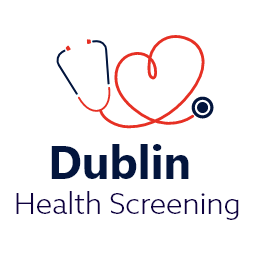 High Blood Pressure (Hypertension) screen at Dublin Health Screening
High Blood Pressure (Hypertension) screen at Dublin Health Screening
Having high blood pressure is one of several ‘risk factors’ that can increase your chance of developing heart disease, a stroke, and other serious conditions. As a rule, the higher the blood pressure, the greater the risk. Treatment includes a change in lifestyle risk factors where these can be improved – losing weight if you are overweight, regular physical activity, a healthy diet, cutting back if you drink a lot of alcohol, stopping smoking, and a low salt intake. If needed, medication can lower blood pressure.
What is blood pressure?
Blood pressure is the pressure of blood in your arteries (blood vessels). Blood pressure is measured in millimetres of mercury (mmHg). Your blood pressure is recorded as two figures. For example, 150/95 mmHg. This is said as ‘150 over 95’.
- The top (first) number is the systolic pressure. This is the pressure in the arteries when the heart contracts.
- The bottom (second) number is the diastolic pressure. This is the pressure in the arteries when the heart rests between each heartbeat.
What is high blood pressure?
High blood pressure is a blood pressure that is 140/90 mmHg or above each time it is taken. That is, the blood pressure is ‘sustained’ at 140/90 mmHg or above. High blood pressure can be:
- just a high systolic pressure, for example, 170/70 mmHg.
- just a high diastolic pressure, for example, 120/104 mmHg.
- or both, for example, 170/110 mmHg.
However, it is not quite as simple as this. Depending on various factors, the level at which blood pressure is considered high enough to be treated with medication can vary from person to person.
Blood pressure of 160/100 mmHg or above
This is definitely high. All people with a blood pressure that stays at this level are usually offered medication to lower it (described later).
Blood pressure of 140/90 mmHg or above but below 160/100 mmHg
This is sometimes called ‘mild’ high blood pressure. Ideally, it should be lower than this but for many people the risk from mild high blood pressure is small, and drug treatment is not indicated. However, certain groups of people with blood pressure in this range are advised medication to lower it. These are people with:
- a high risk of developing cardiovascular diseases (see below), or
- an existing cardiovascular disease (see below), or
- diabetes, or
- damage to the heart or kidney (organ damage) due to high blood pressure.
Blood pressure between 130/80 and 140/90 mmHg
For most people this level is fine. However, current UK guidelines suggest that this level is too high for certain groups of people. Treatment to lower your blood pressure if it is 130/80 mmHg or higher may be considered if you:
- Have developed a complication of diabetes, especially kidney problems.
- Have had a serious cardiovascular event such as a heart attack, TIA or stroke.
- Have certain chronic (ongoing) kidney diseases.
How is high blood pressure diagnosed at Dublin health Screen?
A one-off blood pressure reading that is high does not mean that you have ‘high blood pressure’. Your blood pressure varies throughout the day. It may be high for a short time if you are anxious, stressed, or have just been exercising.
You are said to have ‘high blood pressure’ (hypertension) if you have several blood pressure readings that are high, and which are taken on different occasions, and when you are relaxed.
Observation period
If one reading is found to be high, it is usual for your doctor or nurse to advise a time of observation. This means several blood pressure checks at intervals over time. The length of the observation period varies depending on the initial reading, and if you have other health risk factors. However depending on the reading we are also able to arrange a 24 hour Holter BP monitor which will measure will take around 40 readings of your BP over 24. We will attach same at the practice and you are allowed go home 24 hours later you return to the practice and the results are fed into a computer. You will find out then if you have definite hypertension or if you have a syndrome called white coat syndrome.
One reason this may be advised is because some people become anxious in medical clinics which can cause the blood pressure to rise. (This is called ‘white coat’ hypertension.) Home or ambulatory monitoring of blood pressure may show that the blood pressure is normal when you are relaxed.

Above is a the Holter bp monitor used at Dublin Health Screening.
What causes high blood pressure?
The cause is not known in most cases
This is called ‘essential hypertension’. The pressure in the arteries depends on how hard the heart pumps, and how much resistance there is in the arteries. It is thought that slight narrowing of the arteries increases the resistance to blood flow, which increases the blood pressure. The cause of the slight narrowing of the arteries is not clear. Various factors probably contribute.
In some cases, high blood pressure is caused by other conditions
It is then called ‘secondary hypertension’. For example, certain kidney or hormone problems can cause high blood pressure.
How common is high blood pressure?
In Ireland, about half of people over 65, and about 1 in 4 middle aged adults, have high blood pressure. It is less common in younger adults. Most cases are mildly high (up to 160/100 mmHg). However, at least 1 in 20 adults have blood pressure of 160/100 mmHg or above. High blood pressure is more common in people:
- with diabetes. About 3 in 10 people with Type 1 diabetes and more than half of people with Type 2 diabetes eventually develop high blood pressure.
- from African-Caribbean origin.
- with a family history of high blood pressure.
- with certain lifestyle factors. That is, those who: are overweight, eat a lot of salt, don’t eat many fruit and vegetables, don’t take enough exercise, or drink a lot of alcohol.
Do I need any tests?
If you are diagnosed as having high blood pressure then you are likely to be examined by one of our doctors and have some routine tests which include:
- A urine test to check if you have protein or blood in your urine which is done as standard at the Dublin health screen.
- A blood test to check that your kidneys are working fine, and to check your cholesterol level and sugar (glucose) level again standard at the screen
- A heart tracing (an electrocardiogram, also called an ECG) finally again standard.
The purpose of the examination and tests is to:
- Rule out (or diagnose) a ‘secondary’ cause of high blood pressure such as kidney disease.
- To check to see if the high blood pressure has affected the heart.
- To check for other ‘risk factors’ such as a high cholesterol level or diabetes (see below).
Who should have a blood pressure check?
High blood pressure usually causes no symptoms. You will not know if you have high blood pressure unless you have your blood pressure checked. Therefore, everyone should have regular blood pressure checks at least every 3-5 years. The check should be more often (at least once a year) in: older people, people who have had a previous high reading, people with diabetes, and people who have had a previous reading between 130/85 and 139/89 mmHg (that is, not much below the ‘cut off’ point for high blood pressure).
Why is high blood pressure a problem if it causes no symptoms?
High blood pressure is a ‘risk factor’ for developing a cardiovascular disease (such as a heart attack or stroke), and kidney damage, sometime in the future. If you have high blood pressure, over the years it may have a damaging effect to arteries and put a strain on your heart. In general, the higher your blood pressure, the greater the health risk. But, high blood pressure is just one of several possible risk factors for developing a cardiovascular disease.
What are cardiovascular diseases?
Cardiovascular diseases are diseases of the heart (cardiac muscle) or blood vessels (vasculature). However, in practice, when doctors use the term ‘cardiovascular disease’ they usually mean diseases of the heart or blood vessels that are caused by atheroma. Patches of atheroma are like small fatty lumps that develop within the inside lining of arteries (blood vessels). Atheroma is also known as ‘atherosclerosis’ and ‘hardening of the arteries’.
Risk factors
Everybody has some risk of developing atheroma which may cause one or more cardiovascular diseases. However, certain ‘risk factors’ increase the risk. Risk factors include:
- Lifestyle risk factors that can be prevented or changed:
- Smoking.
- Lack of physical activity (a sedentary lifestyle).
- Obesity.
- An unhealthy diet.
- Excess alcohol.
- Treatable or partly treatable risk factors:
- Hypertension (high blood pressure).
- High cholesterol blood level.
- High trigliceride (fat) blood level.
- Diabetes.
- Kidney diseases that affect kidney function.
- Fixed risk factors – ones that you cannot alter:
- A strong family history. This means if you have a father or brother who developed heart disease or a stroke before they were 55, or in a mother or sister before they were 65.
- Being male.
- An early menopause in women.
- Age. The older you become, the more likely you are to develop atheroma.
However, if you have a fixed risk factor, you may want to make extra effort to tackle any lifestyle risk factors that can be changed.
Note: Some risk factors are more ‘risky’ than others. For example, smoking and high blood pressure cause a greater risk to health than obesity. Also, risk factors interact. So, if you have two or more risk factors, your health risk is much more increased than if you just have one. For example, a middle aged male smoker who takes no exercise and has high blood pressure has a high risk of developing a cardiovascular disease such as a heart attack before the age of 60.
Assessing (calculating) your cardiovascular health risk
A ‘risk factor calculator’ is often used by doctors and nurses to predict the health risk for an individual. A score is calculated which takes into account all your risk factors (such as age, sex, smoking status, blood pressure, blood cholesterol level, etc). If you want to know your ‘score’, see your practice nurse or GP. Current Irish guidelines advise that if your score gives you a 2 in 10 risk (or more) of developing a cardiovascular disease within the next 10 years, then treatment is advised. Treatments may include:
- A drug to lower blood pressure if it is 140/90 mmHg or higher.
- A drug to lower your cholesterol level.
- A daily low dose of aspirin. This reduces the risk of blood clots forming in the blood vessels over patches of atheroma (which cause strokes and heart attacks).
- Where relevant, to encourage you to tackle ‘lifestyle’ risk factors such as smoking, lack of physical activity, diet, and weight.
How can blood pressure be lowered?
Regular physical activity
If possible, aim to do some physical activity on five or more days of the week, for at least 30 minutes. For example, brisk walking, swimming, cycling, dancing, etc. Regular physical activity can lower blood pressure in addition to giving other health benefits. If you previously did little physical activity, and change to doing regular physical activity five times a week, it can reduce systolic blood pressure by 2-10 mmHg.
Have a low salt intake
The amount of salt that we eat can have an effect on our blood pressure. Government guidelines recommend that we should have no more than 5-6 grams of salt per day. (Most people currently have more than this.) Tips on how to reduce salt include:
- Use herbs and spices to flavour food rather than salt.
- Limit the amount of salt used in cooking, and do not add salt to food at the table.
- Choose foods labelled ‘no added salt’, and avoid processed foods as much as possible.
Eat a healthy diet
Briefly, this means:
- AT LEAST five portions, and ideally 7-9 portions, of a variety of fruit and vegetables per day.
- THE BULK OF MOST MEALS should be starch-based foods (such as cereals, wholegrain bread, potatoes, rice, pasta), plus fruit and vegetables.
- NOT MUCH fatty food such as fatty meats, cheeses, full-cream milk, fried food, butter, etc. Use low fat, mono-, or poly-unsaturated spreads.
- INCLUDE 2-3 portions of fish per week. At least one of which should be ‘oily’ such as herring, mackerel, sardines, kippers, pilchards, salmon, or fresh (not tinned) tuna.
- If you eat meat it is best to eat lean meat, or poultry such as chicken.
- If you do fry, choose a vegetable oil such as sunflower, rapeseed or olive oil.
- Low in salt.
A healthy diet provides health benefits in different ways. For example, it can lower cholesterol, help control your weight, and has plenty of vitamins, fibre, and other nutrients which help to prevent certain diseases. Some aspects of a healthy diet also directly affect blood pressure. For example, if you have a poor diet and change to a diet which is low-fat, low-salt, and high in fruit and vegetables, it can lower systolic blood pressure by up to 11 mmHg.
Drink alcohol in moderation
A small amount of alcohol (1-2 units per day) may help to protect you from heart disease. One unit is in about half a pint of normal strength beer, or two thirds of a small glass of wine, or one small pub measure of spirits.
However, too much alcohol can be harmful.
- Men should drink no more than 21 units of alcohol per week (and no more than four units in any one day).
- Women should drink no more than 14 units of alcohol per week (and no more than three units in any one day).
Cutting back on heavy drinking improves health in various ways. It can also have a direct effect on blood pressure. For example, if you are drinking heavily, cutting back to the recommended limits can lower a high systolic blood pressure by up to 10 mmHg.

